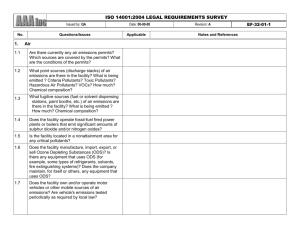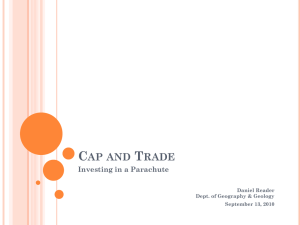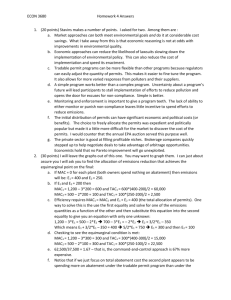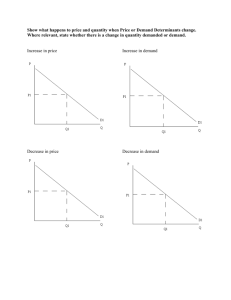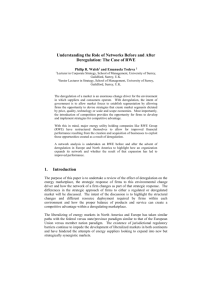Money and Lobbyists Hurt European Efforts to Curb Gases
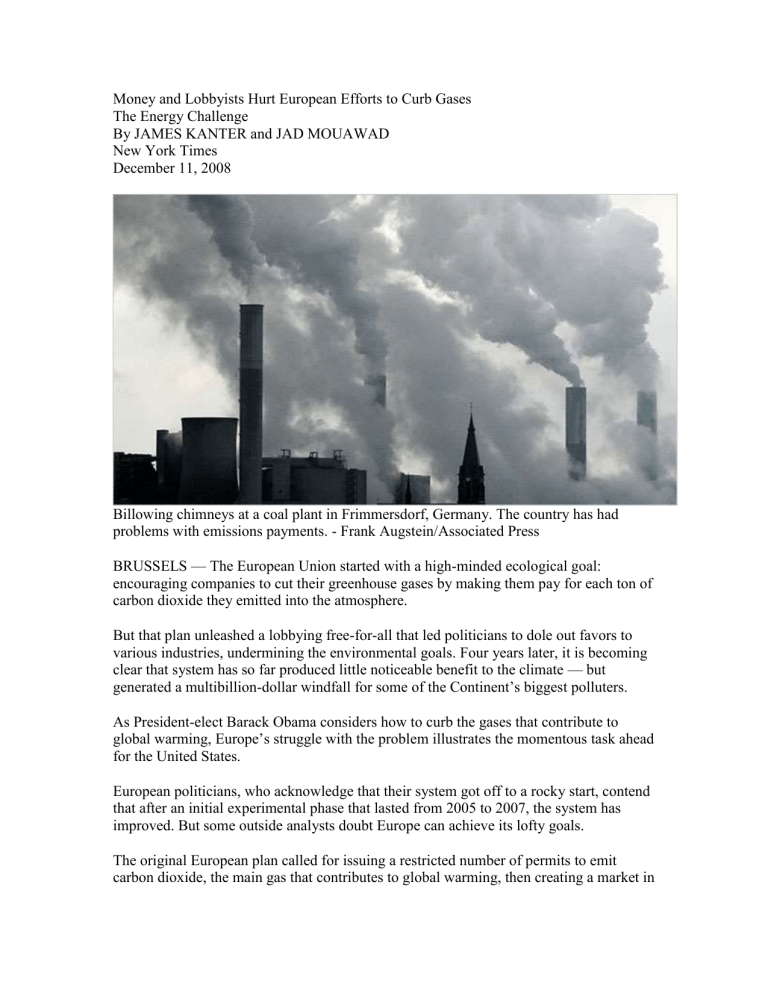
Money and Lobbyists Hurt European Efforts to Curb Gases
The Energy Challenge
By JAMES KANTER and JAD MOUAWAD
New York Times
December 11, 2008
Billowing chimneys at a coal plant in Frimmersdorf, Germany. The country has had problems with emissions payments. - Frank Augstein/Associated Press
BRUSSELS — The European Union started with a high-minded ecological goal: encouraging companies to cut their greenhouse gases by making them pay for each ton of carbon dioxide they emitted into the atmosphere.
But that plan unleashed a lobbying free-for-all that led politicians to dole out favors to various industries, undermining the environmental goals. Four years later, it is becoming clear that system has so far produced little noticeable benefit to the climate — but generated a multibillion-dollar windfall for some of the Continent’s biggest polluters.
As President-elect Barack Obama considers how to curb the gases that contribute to global warming, Europe’s struggle with the problem illustrates the momentous task ahead for the United States.
European politicians, who acknowledge that their system got off to a rocky start, contend that after an initial experimental phase that lasted from 2005 to 2007, the system has improved. But some outside analysts doubt Europe can achieve its lofty goals.
The original European plan called for issuing a restricted number of permits to emit carbon dioxide, the main gas that contributes to global warming, then creating a market in
which they could be freely traded. If a company produced more gas than its permits allowed, it would be penalized by having to buy more; if it managed to reduce emissions by switching to cleaner fuels or technologies, it would be able to sell its permits to polluting companies. The marketplace would set the price.
In the United States, a similar market approach is credited with reducing acid rain, another environmental problem. The system encourages efficiency and innovation by rewarding companies that can cut the most pollution at the lowest cost.
But global warming is a far larger, more complicated problem than acid rain, and setting up a workable market in Europe has proved to be difficult and contentious. As the incoming Obama administration contemplates creation of an American market,
Washington has already seen the beginnings of the same lobbying frenzy that bedeviled
Europe.
Beseeched by giant utilities and smokestack industries that feared for their competitiveness, the European Union scrapped the idea of forcing industries to buy their permits, with the money going to public coffers. Instead, governments gave out the vast majority of the permits for nothing, in such quantity that the market nearly collapsed. The basic question of whether to sell permits, give them away or do some of both has yet to be resolved in the United States.
“Everybody will fight their own corner,” said Nicholas Stern, a British economist, who recommended that the United States charge for a substantial number of permits rather than dole them all out as the Europeans have. “That’s why it’s so important to have a clear conception from the start, to start off with a clear strategy.”
After the initial crash, Europe tightened its system and issued new permits, and they have acquired substantial value. Nearly $80 billion will change hands in 2008 on the European emissions market, making it by far the world’s largest, according to estimates by Andreas
Arvanitakis, an analyst at Point Carbon, a research firm.
Much of the cost of the European system is being paid by the public in the price of goods and services, including higher electricity bills, but whether the money is doing any good is an open question. The amount of carbon dioxide emitted by plants and factories participating in the system has not fallen. Their emissions rose 0.4 percent in 2006 and another 0.7 percent in 2007.
Meanwhile, a series of disputes has erupted about the way companies are carrying out the system.
A German Example
The case of Germany, Europe’s largest economy, illustrates the many problems in
Europe’s approach. For instance, RWE, a major German power company and Europe’s largest carbon emitter, received a windfall of about $6.4 billion in the first three years of
the system, according to analyst estimates. Regulators in that country have accused utilities of charging customers for far more permits than was allowable.
This week, leaders of the European Union are meeting in Brussels to shape the next phase of their system, and find ways to cut greenhouse gas emissions by 20 percent by 2020.
They also seek to close loopholes worth billions to various industries, while confronting the same tug of war between long-term environmental goals and short-term costs that proved so vexing the first time around.
The European summit meeting coincides with a round of negotiations among 190 nations to establish a new global treaty limiting greenhouse emissions, a treaty the Obama administration might seek to join.
Pressure From Lobbyists
During long negotiations on the landmark Kyoto climate treaty more than a decade ago, the Clinton administration pushed to include emissions trading as a means of achieving the goals, favoring that approach over energy taxes or traditional regulatory limits on emissions.
Even after the Americans backed out of ratifying Kyoto, Europe decided to set up the world’s first large, mandatory carbon-trading market. “I was eager to put it in place as soon as possible,” said Margot Wallstrom, the European Union’s environment commissioner then.
From the start, Ms. Wallstrom, now a vice president of the European Commission, said she was lobbied heavily by governments and by companies seeking to limit the financial burden.
The initial idea of charging for many of the permits never got off the ground. Many politicians feared that burdening European industries with extra costs would undercut their ability to compete in a global marketplace. In the end, the decision was made to hand out virtually all the permits free.
With European Union oversight, individual countries were charged with setting emissions levels and distributing the permits within their borders, often to companies with strong political connections.
Jürgen Trittin, a former Green Party leader who was the German minister of environment from 1998 to 2005, recalled being lobbied by executives from power companies, and by politicians from the former East Germany seeking special treatment for lignite, a highly polluting soft brown coal common around central Europe.
The framework of the European system put governments in the position of behaving like
“a grandfather with a large family deciding what to give his favorite grandchildren for
Christmas,” Mr. Trittin said in an interview.
The debates on what limits to set for carbon dioxide emissions were particularly arduous.
Mr. Trittin recalled a five-hour “showdown” in March 2004 with Wolfgang Clement, then the economy minister, in which he lost a battle to lower the overall limit. It was eventually set at 499 million tons a year, a reduction of only 2 million tons.
In a recent e-mail message, Mr. Clement did not challenge the details of his former colleague’s account, but he characterized as “just nonsense” Mr. Trittin’s claims of undue industry influence. He said the Greens were unrealistic about what could be achieved.
“I reproached them — and I’m doing this still today — that at the end of their policy there is the de-industrialization of Germany,” Mr. Clement said. “That’s our conflict.”
Eberhard Meller, the president of the Federation of German Electricity Companies, which represents companies like RWE, said, “Good sense triumphed in the end.” For his part,
Mr. Clement eventually joined the supervisory board of RWE Power, in 2006.
The benefits won by German industry were substantial. Under the plan that the European
Union originally approved for Germany, electricity companies were supposed to receive
3 percent fewer permits than they needed to cover their total emissions between 2005 and
2007, which would have forced them to cut emissions.
Instead, the companies got 3 percent more than needed, according to the German
Emissions Trading Authority, the regulatory agency, a windfall worth about $374 billion at the peak of the market. German lawmakers also approved exemptions and bonuses that could be combined in dozens of ways and allowed companies to gain additional permits.
“It was lobbying by industry, including the electricity companies, that was to blame for all these exceptional rules,” said Hans Jürgen Nantke, the director of the German trading authority, part of the Federal Environment Agency.
Higher Bills Draw Inquiry
After the system kicked off, in 2005, power consumers in Germany started to see their electrical bills increase by 5 percent a year. RWE, the power company, received 30 percent of all the permits given out, more than any other company in Germany.
The company said its price increases from 2005 to 2007 predominantly reflected higher costs of coal and natural gas. But the company acknowledged charging its customers for the emission permits, saying that while it may have received them free from the government, they still had value in the marketplace.
The German antitrust authority later investigated. In a confidential document sent to
RWE lawyers in December 2006, that agency accused RWE of “abusive pricing,” piling on costs for industrial clients that were “completely out of proportion” to the company’s
economic burden, according to the document, which was obtained by The New York
Times.
Without admitting wrongdoing, RWE last year agreed to a settlement that should provide lower electricity rates to industrial customers in Germany from 2009 through 2012.
Meanwhile emissions have risen at RWE’s German operations since the trading system began. The company emitted nearly 158 million tons of carbon dioxide in 2007, compared with 120 million tons in 2005, according to its annual reports.
The company said its emissions rose in part because one of its nuclear power stations, which emit no carbon dioxide, was off line for a while.
Jürgen Frech, the chief spokesman for RWE, said that charging customers for the carbon permits was “beyond reproach,” and added that the company will spend more than $1 billion this year to comply with the emissions trading system. RWE also said it is investing $41 billion over the next five years in projects including renewable energy and developing cleaner ways to generate electricity from coal mined in Germany.
For all the problems with the European system, some experts say it is simply too early to judge whether it will succeed. As the region that went first with mandatory carbon trading, Europe was bound to make some initial mistakes, they said.
Call It Experimental
“People who don’t want to do anything about carbon emissions in the United States are quick to say the European system was a failure,” said Eileen Claussen, president of the
Pew Center on Global Climate Change in Washington. “But they don’t understand this was an experiment to learn how to get things right.”
Supporters of carbon trading in Europe contend that significant reductions should be achieved starting this year because limits on emissions have been tightened. But negotiations on how to meet even more ambitious targets after 2012 are in danger of coming undone as the economy worsens.
Poland — which depends on coal-fired plants for 95 percent of its electricity — has threatened to block the next phase of Europe’s emissions plan unless a way is found to lessen the burden on its energy sector. Its fears echo the position of some American states that depend on coal for their electricity; they worry about huge cost increases should
Congress pass a global warming bill.
France’s president, Nicolas Sarkozy, is leading the political horse-trading on Europe’s new system after 2012.
“Europe,” he said on Saturday in Poland, “must be an example for others.”
Jad Mouawad reported from New York and Paul Geitner from Paris.






